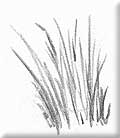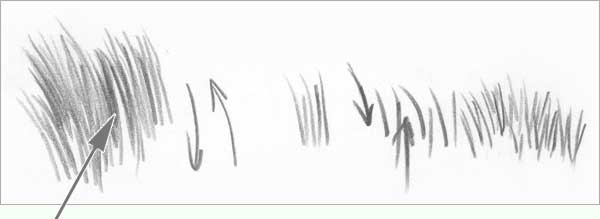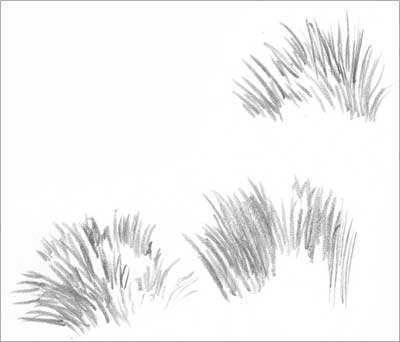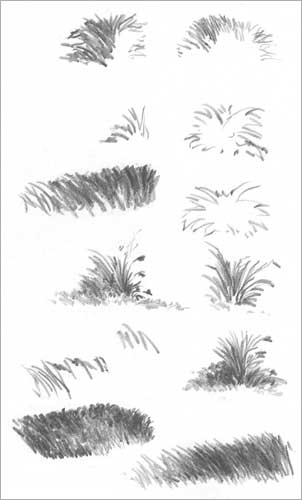How to draw Grass and Weeds
Tutorial by Diane Wright
- part one
- part two

part one
Introduction
Grass and weeds are some of the most challenging nature elements to capture in a landscape drawing. It is seldom the focal point of a landscape, but if not rendered correctly, can negatively impact the rest of the scene. Grass is a supporting actor of the presentation. It should mirror the feeling of the scene, light and wispy for a foggy view, dark and dramatic with lots of texture for a thicker carpet. Grass is never stagnant, it is forever moving. This movement, flow and direction we impose can guide the viewer to where we want to take them, right into the depths of the scene.A simple pencil stroke
At the most basic level, drawing grass is just a mark on the paper. Well perhaps two marks, one up and one down. As you start the pencil stroke, the pressure is firm and as you move up, the pressure is lifted so when you lift the pencil from the paper the line is tapered. As you make the mark on the downward stroke, it starts with a heavier pressure and is tapered at the bottom. This vertical "rocking" motion of up/down pencil strokes is all it takes. As you are creating these up/down marks, you are actually drawing the area or shadow between the blades. The white area left is the actual blades of grass. This technique is called negative drawing.
Negative drawing - the pencil stroke is depicting the shadows or the area between the grass blades.

Practice
Practice drawing various "textures" to depict grass. Here are a few tips:


- Vary the length of the grass. Unless the grass is from a manicured urban lawn, the grass will not be the same length. Varying the length will add interest.
- A slight arch with the pencil stroke will keep the grass from looking stiff and unnatural.
- Add a variety of weeds including broad leaf plants. Again this will add interest to your scene.
- Create light, wispy grass with lighter pencil strokes.
- For a thicker carpet of grass, use shorter, firmer pencil stroke.
- For large sections of grass, use a 4H or 2H chisel point lead and layer a light tone over the area. This will add uniformity.
How much detail?
So how much detail should be used when depicting grass? Well, that depends on what your landscape dictates. Grass in the far distance is easy as it should be nothing more than a tonal value. Even around the tree in the foreground of "Honey Creek", the grass is little more than a texture.
It isn't until you get to the closest foreground area that you "might" be able to distinguish individual blades of grass. By keeping this in perspective, it makes drawing grass so much easier as it is now just another "texture" added to the landscape.
- part one
- part two




